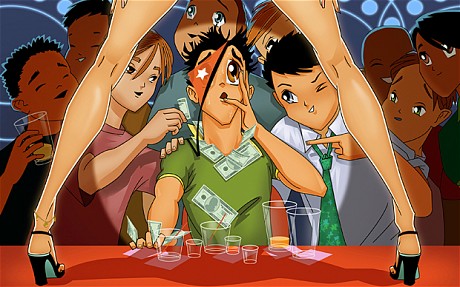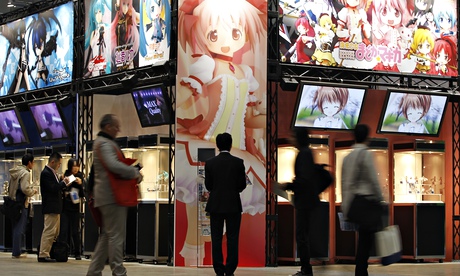How Japan's Ban On Child Porn Does Little To Prevent The Sexualisation Of Young Girls
Yielding to years of pressure to fall in line with the rest of the developed world, Japan finally banned the possession of child pornography on Wednesday. But the new law left untouched the nation’s popular and sometimes sexually explicit manga and anime comics as well as other portrayals of young girls as objects of sexual desire.
After years of international pressure, Japan has finally voted to ban the possession of child pornography, thus sealing the loophole that allowed pedophiles to slide under the radar
Japan's parliament on Wednesday finally banned the possession of child pornography, making it a crime punishable by up to a $9,800 fine and a year in prison.
The move makes Japan the last nation in the Organization for Economic Cooperation and Development (OECD) to ban the possession of child porn. And though Japan previously outlawed the making of child porn, it did not punish simple possession of it.
However, the law still has a loophole permitting cartoon depictions of child porn in anime and manga, often referred to as lolicon
The exclusion was made after publishers' and lawyers' associations contended that a ban on such images would violate the constitutional right of free speech.
The new law, although, specific to "photographs and videos showing actual children," also leaves untouched a vast gray area in which young girls are depicted in sexually suggestive ways
A street last month in Tokyo’s Akihabara shopping district, one of the city’s top tourist draws, where the sexuality of young girls is on prominent display
Image via nyt.comThis includes everything from images of the all-girl bands of Japanese pop music posing in lingerie and bikinis, to fantasy illustrations with the faces of prepubescent girls atop the scantily clad bodies of voluptuous adults.
 gawker.com
gawker.com
Such images attest to Japan’s more casual social attitudes when it comes to the sexual objectification of women of all ages, and also toward the consumption of pornography itself. (Reflecting those attitudes, the passage of the law barely merited a mention on the nightly news.)
Manga comics with graphic illustrations of sex are sold in neighborhood convenience stores and on train station platforms, and until the proliferation of smartphones, it was common to see men openly reading the comics and magazines featuring nude women while commuting to work.
cnn.comThe fascination with the sexuality of young girls even has its own name in Japanese, "rorikon" — which stands for the "Lolita complex" — and is on prominent display in Tokyo’s Akihabara shopping district
Foreign visitors and locals can be seen there ogling explicit manga-derived posters, shirts and even small plastic dolls of young girls with highly exaggerated hourglass figures.
They stare wide-eyed from the pages of magazines, childlike in stature but engaged in extremely explicit sexual activities. They may be drawings, but critics say the images found on the pages of some of Japan's erotic manga are so disturbing they should be banned.
cnn.comThe new law on child pornography is partly the result of a push by the Japanese police, who said that the failure to outlaw possession in the 1999 law had created enough continuing demand that the number of criminal cases involving the production and circulation of child pornography skyrocketed. That number jumped tenfold since 2000, to 1,644 cases last year, according to the National Police Agency.
What is manga?
The term manga means "casual drawing." The earliest examples date back to the 7th century, but it became very popular in the post-war period, Macquarie's Bryce said. That coincided that with the work of the so-called "God of manga" Tezuka Osamu, the creator of "Astro Boy," one of the more popular Japanese characters that made the leap into Western media.
Now the industry is worth an estimated $3.6 billion in comic book and magazine sales, according to the Publishing Science Institute figures from 2013. Animation takes in another extra $2.3 billion, according to the Media Development Research Institute. As Bryce points out, only a very small proportion of the market peddles sexually explicit material involving children. "Very often people think manga equals sexual or manga equals violence. But it's only a part of manga... there are some very poetic, very beautiful ones," she said.
cnn.comHow explicit are they?
To see what's being openly sold on Japanese shelves, CNN took a hidden camera to one of the many manga stores in the Akihabara district of Tokyo. The district is a known hub for "otakus," obsessive members of anime and manga fandom, a worldwide group of avid followers of the genre.
cnn.comDown a set of stairs, there are rows and rows of manga, many containing popular themes and images. But five feet away, in an area marked "adults only," the content took a sharp turn into shocking sex scenes, apparently involving minors. Some of the predominantly female characters wore school uniforms, hair clips and innocent expressions as they engaged in sometimes violent sex acts with dominant characters.
cnn.comShould it be banned?
Mio Bryce, an expert on anime and manga from Macquarie University in Sydney, said Japan's obsession with "kawaii" or cuteness made it difficult to distinguish whether the characters in the material were depicting children or not. "Cuteness means a generally more infantile character. Maybe the character is 20 years old, but maybe from your point of view, the character's 15 years old. It's very difficult," she said.
Ken Akamatsu, who lobbies lawmakers on behalf of the Japan Cartoonists Association, said a total ban on explicit content would damage the entire industry, making creators too scared to put pen to paper in case they risked breaking the rules. He said the characters were imaginary, so unlike real child porn, no one was hurt. "Actual children suffering and crying is not acceptable. But manga doesn't involve actual children. So there are no actual victims," he said.
cnn.comChild welfare advocates disagree. Shihoko Fujiwara runs Lighthouse, a nonprofit for exploited children. She told CNN she once worked on a case where a predator used a cartoon to convince a child that sex abuse was normal. "So the pedophiles might bring the animation and say 'this is how you practice with adults,'" she said.
The bigger problem, however, is that manga permeates Japanese culture. It can be seen everywhere, from street signs to government pamphlets.
Often, the characters depicted are young, vulnerable girls who meet consumers' desires for something "kawaii" or "cute." "'Cuteness is a problem," she said. "Because cuteness is something that makes you feel you have to protect the person, and there's a very fine line between 'I can protect the person' and 'I can control the person.'"
cnn.comShe said the prevalent depiction of young girls, especially in "Lolita complex" material, risks giving "the wrong impression of women." "If you're looking at it all the time, how are you actually seeing people? Is it just a fantasy, or maybe some people with a bit of a wrong mind think that is actually there, and that is the way to treat women. So there is a risk," she said.
The new law, which is expected to go into effect next month, will give violators a one-year grace period to get rid of pornographic images before they will be prosecuted
Speaking in Parliament, the justice minister, Sadakazu Tanigaki, said he hoped the new law would spur a broader change in social attitudes by sending a clear signal that it is no longer acceptable to objectify children. “We must fight against a tendency of looking at children as sexual objects, and allowing them to be taken advantage of, sexually and commercially,” he told the upper house on Tuesday, a day before it voted the bill into law. The lower house had passed the bill earlier in the month.






